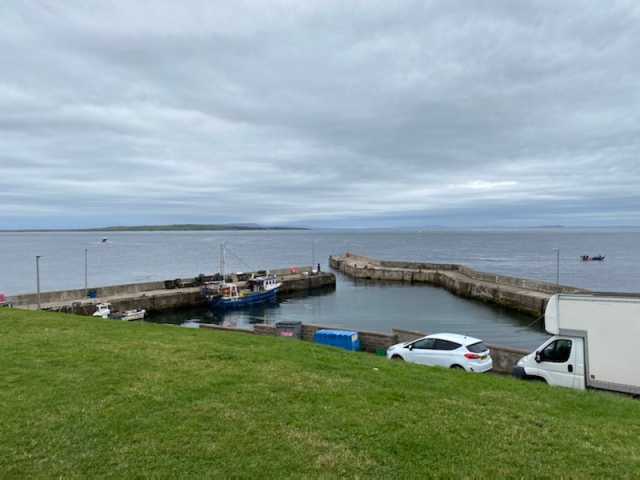
I thought it might be interesting to take some of the less relevant episodes – the ‘out-takes’ – from the just-completed Scottish workshop (and subsequent journey to Orkney) and run them in reverse time-sequence. The Thursday blogs, here, will continue with the linear sequence of the Scottish and Orkney explorations.
That way the odd bits of the journey and the main storyline would meet somewhere in the middle – I have no idea where! Let’s see what happens…
The above image worked better than I thought it would. At face value, it could be a giant slide attached to a hotel on a headland, with a sandstone rock hitching a ride and about to decapitate the observer!
But it’s not, of course. It’s part of a sculptural installation on the headland at John O’ Groats, the most northerly point on the British mainland, and a few sea miles from the archipelago of Orkney, from which we had just sailed… at 06:15 in the morning.

North of John O’ Groats – between the coast and Orkney – is the Pentland Firth, famous for its fast and ferocious tides and cross-currents. Dire-sounding weather and tidal warnings for Pentland Firth are regular features of BBC weather broadcasts.
The deadly tidal rapids on the surface of the Pentland Firth are common knowledge, but less well-known are the resulting activities beneath the sea. Recently, a new insight was gained when researchers, supporting the growing commercial interest in the harnessing of some of the Firth’s vast tidal power, began surveying the seabed with a view to locating permanent turbines on the ocean floor.
During this exercise, it was discovered that large rolling boulders of up to 1.5 tons in weight – similar to that of an average car – were regularly moved great distances across the seabed by forceful currents!
This fascinated local artists Matthew Dalziel and Louise Scullion, whose work focusses on art and sculpture inspired by ecology and natural phenomena.

They put forward a proposal for a sculptural installation that mirrored their own delight at the thought of large deep-sea boulders wandering along the sea bed, powered by the stormy waves above. The result is what you see in the above photographs; something that puts John O’ Groats on the modern artistic map.

The information board sets the context:
‘Across the world, boulders that defy the weightiness, their solid stability and static nature and hint instead at a more animated past are often celebrated. Small pilgrimages are made to visit them and share in their unusual power...

… While the Nomadic Boulders of John O’Groats will forever remain shrouded in the deep and stormy depths of the sea, this monument serves to bring them to our consciousness, perhaps affording a tantalising glimpse of the world beneath the sea.’

Having sailed from Orkney on the early ferry, we were hoping to break the trip around the coast with a hot drink, before the long drive south. But at nine in the morning, on our first ever visit, John O’Groats was closed. We couldn’t even get a a cup of coffee. Scenic, though, and Larissa, one of our travelling companions and a skilled photographer, did gift us a fine portrait at the famous signpost.

To be fair, John O’ Groats is a fine and symbolic place, The harbour is lovely, and a pleasant place to wander around. The main view, though, is the sight of the Pentland Firth, and, beyond that, the outline of the Orkney archipelago.


©Copyright Stephen Tanham, 2020.
